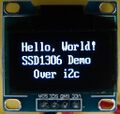TS-7180 TWI
The i.MX6 supports standard I2C at 100khz, or using fast mode for 400khz operation. The CPU has 2 I2C buses used on the TS-7180.
I2C 1 is internal to the TS-7180 and connects to the onboard Silabs supervisory microcontroller at 100khz; and to the onboard ST M41T00S real-time clock (RTC).
| Address | Device |
|---|---|
| 0x4a | #Silabs |
| 0x68 | #RTC |
The second I2C bus is connected to the onboard FPGA. This bus also runs at 400khz by default.
| Address | Device |
|---|---|
| 0x28-0x2f | #FPGA |
In addition to the CPU i2c buses, a bit-banged i2c interface is available on the daughter-card interface, using gpio. The following command will instantiate (create a device node for) a new ssd1306 display at I2C address 0x3C:
echo ssd1306 0x3c > /sys/bus/i2c/devices/i2c-4/new_device
Once this is done, i2c-tools can manipulate the I2C device, or a the downstream developer can write their own client. Technologic Systems has provided a simple client program for writing to an SSD1306 OLED display connected to the HD1 connector. The photo below shows output on the display.
Download the source-code tarball here: File:Ssd1306-demo.tar.gz
| Note: | It is also possible to request the kernel to bitbang additional I2C buses as needed. See an example here. |
The kernel makes the I2C available at /dev/i2c-#. You can use the i2c-tools (i2cdetect, i2cget, i2cset), or you can write your own client.
